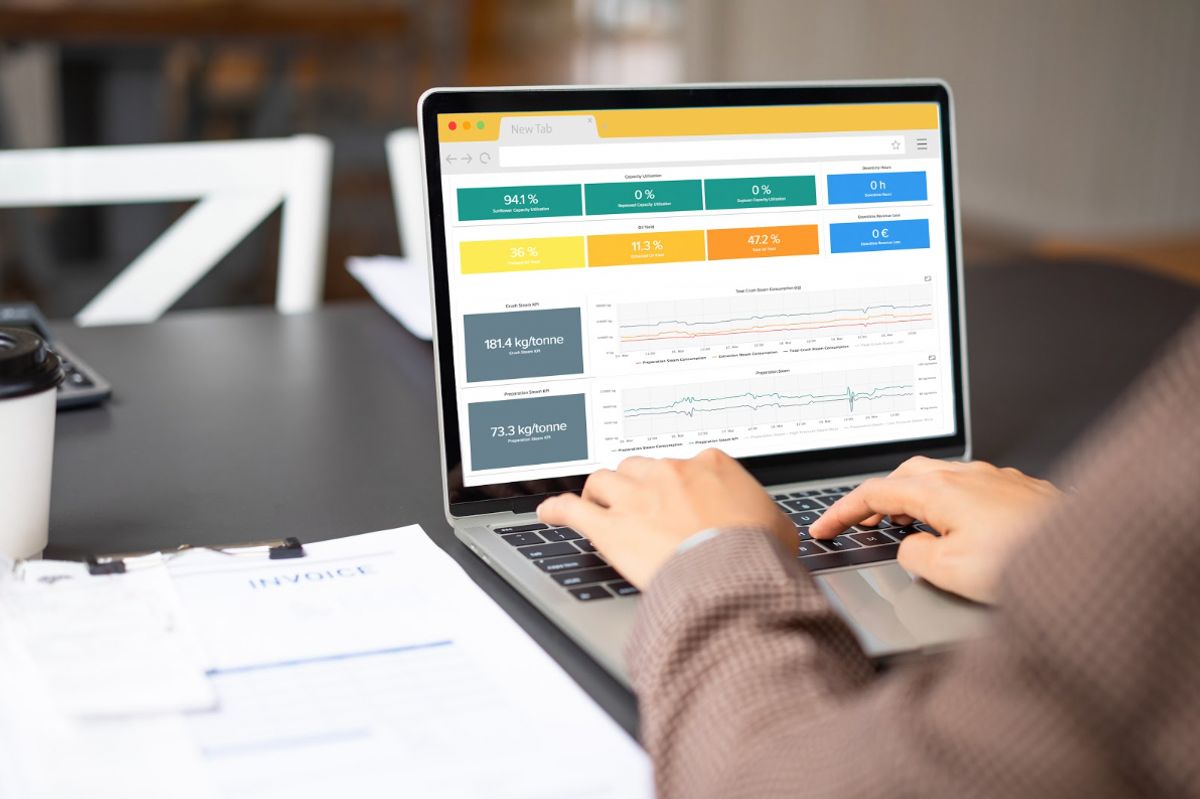What is Energy Modelling?
The goal of energy modelling is to provide insights into how a process is currently using energy and how that use pattern might change if you make changes to the operation or design of that process.
You might have a good understanding of how much fuel you’re burning in your boiler each month, but not be quite sure exactly which parts of your plant are using the steam or how much is being lost through poor insulation.
You might be considering upgrading one of your coproducts, perhaps by transforming it in a new batch reactor, but are unsure whether you have enough cooling available to meet the peak demand of the recipe.
You might be interested in installing a Combined Heat and Power (CHP) unit to reduce your carbon footprint, but are unsure exactly how it will impact your existing equipment and capacity.
By putting together a model of your energy systems, and ideally your whole process, you should gain insights into how much heat and power are being used in different parts of your plant, and how that changes with intentional (e.g. production plan and equipment design) and unavoidable (e.g. ambient conditions) changes.
Two Main Approaches to Energy Modelling
There are two main approaches to energy modelling: statistical modelling and mechanistic modelling.
Statistical Modelling
Statistical modelling relies on reviewing a large data set of past operations and allows the user to draw inferences about energy use patterns. For example, you may be able to infer how freezer demand maps to the throughput of different chilled products or how cooling tower performance changes with weather conditions.
Statistical models have been much in the news recently – as larger data sets and more powerful computers become available, techniques like machine learning and artificial intelligence have garnered renewed interest.
Mechanistic Modelling
Mechanistic modelling relies on reducing the underlying physics and chemistry of a process into mathematical formulae that can then be solved either in general tools (like Excel or Python) or in specialist modelling software (like Aspen or SuperPro).
Such models will typically capture the details of how the process equipment is connected and what its design specifications are and will generally do a good job of estimating the energy use throughout a process.
Of course, many plants also use “original neural networks”, relying on the brains for process experts to understand how the processes work, usually based on years of experience in actually running the equipment.
For either modelling approach to work effectively, it is essential to use such process experts to help guide the model development, sense-check the results, and then leverage the predictive power of the models that are generated.
Different modelling techniques have different strengths and weaknesses
Statistical models are generally easier to develop and require less process expertise, but they rely on having large bodies of relatively clean data to build from. While they are generally very good at reviewing an existing operational history and understanding what previous operating points were best, they are generally not very good at extrapolating outside that historical range.
A statistical model, therefore, will usually not be able to predict the impact of process redesign or a major shift in SKU production (indeed, they would probably need to be retrained on an new data set), and they generally don’t provide a lot of insight into where and how energy is being used in a plant (without much submetering).
Mechanistic models, on the other hand, can be used to design plants that have not yet been built. They tend to be able to be extrapolated and to provide insights into the details of the mass and energy balance of the process, allowing the user to infer submetering patterns.
The drawback with such models, though, is that they typically require expert knowledge of both engineering fundamentals and computer analysis to develop. They are also only as good as the assumptions and level of detail that is incorporated into the computer code – the age old “Garbage in, garbage out” problem.
Increasingly, “hybrid models” and “ digital twins ” are being developed and deployed that use a mechanistic framework to provide a reliable structure (e.g. make sure that the energy balance is closed), and a statistical toolset to use live data to pull the model’s predictions closer to the plant’s actual performance.
What Does Energy Modelling do?
Energy modelling provides insight into how and where energy is being used in the process and how that use pattern changes over time. Ideally, the model will cover the whole facility and include insights into the process as well as the energy systems.
In many manufacturing plants, steam is used to provide heating (e.g. in the reboiler of a distillation column), as an injected ingredient (e.g. for flash cooking), and as pressurized gas to perform work (e.g. pulling vacuum in a steam jet). A boiler(s) at such a facility will typically provide steam to dozens or even hundreds of users, so putting flow meters on each use point would be prohibitively expensive.
However, for the plant manager and the operations team, understanding how the steam is being used can provide some very valuable insights – where might new equipment reduce the heating demand? Where might steam be replaced with a less expensive fluid? Comparing the ideal use pattern with the actual can also provide insights into possible operating issues – are my steam traps or network pipes leaking? Are heat exchangers fouling? Learn how to get a more efficient boiler in your plants.
Refrigeration is also used in many applications to provide cooling down to as low as -50°C in food plants and even lower in cryogenic processes like gas separation. The refrigeration systems are often complicated, with multiple compressors providing cooling at several different temperatures (e.g. -40°C air in a blast freezer, -10°C glycol for a cold room and 5°C for an air conditioner).
The load on these different compressors can vary greatly, for example with seasonal and daytime cycles or with production of different SKU’s (e.g. individual portions vs. value packs). The complex interaction between the electrical demands of the compressors, the heat rejection through the evaporative condensers and the cooling requirements of different products means that it is extremely difficult to intuit the best way to set up the system.
A good energy model can not only untangle the complex interactions and identify the best setup for a process, it can repeat that optimization on demand – rebalancing the plant every 10 minutes, 24h a day, 365 days a year.
Electricity is as ubiquitous in operating facilities as it is in the rest of our lives, and that ease of access means that it’s surprisingly easy to lose track of where the power is being used – keeping tabs on the hundreds of motors, lights, computers and other users of electricity can quickly become overwhelming.
Comparing the actual to expected use of power can also be tricky if the use patterns keep changing (e.g. mixing power as a tank fills or empties).
A good energy model can organize this complexity, providing insights into large users, comparing the performance of similar units and estimating how processing conditions are likely to change operating patterns.
In one recent example, simply comparing the power draw of two parallel air compressors with the same nominal load and design revealed that one was using 25% more power than the other – a clear opportunity.
What Does Energy Modelling Require?
The key to a successful energy modelling program is a commitment to follow through.
While there’s a lot of effort involved, it’s relatively easy to set up an initiative and spend some capital on new equipment to garner some quick wins.
Without a commitment to follow through on those energy projects , though – to monitor them for ongoing success and track how the process changes over time – those gains can decay over the course of a year or two.
That’s where energy management and modelling can be particularly powerful – it can not only identify low-hanging fruit, but it will continue to monitor the system so that you can keep harvesting it.
By setting up a program that systematizes the process data into clear, comprehensive summaries and actionable insights, a good energy management system can make it much easier to track and correct performance.
By linking that system to an energy model that can be updated (either through human intervention or machine learning), the site’s understanding of that performance and future opportunities can be enhanced and developed – you can start picking the fruit from higher up the tree.
Why do Companies Need Energy Modelling?
A good energy model gives you a structured approach to capture the complexity of your process’s energy use patterns.
The best ones integrate your various systems (steam at several pressures, electricity use, cooling and refrigeration , compressed air , …) together to allow you to understand the interaction between the networks and the process.
It also provides you with a learning platform so that the intricacies of those interactions can be improved over time – as the process/market changes, for example, or as new insights are gained.
By structuring the data, you can also present it in different ways – the site management team may want to quantify the energy spend and see which products are more expensive to produce; the procurement team may want to estimate needs in order to hedge future purchases; the sustainability team may want to understand the primary energy sources being used as well as the amounts, to calculate Scope 1 and 2 carbon footprints; the corporate team may want to review Key Performance Indicators to compare multiple facilities in their fleet.
The energy modelling system should not only be able to provide this underlying data set but also an interface that can directly generate different reports for different audiences.
What are Some Examples/Applications of Energy Modelling?
Starting with the simple, CoolPlanetOS was recently installed on a compressed air system. The machine room had two main compressors and a demand that could normally be met by just one machine. The local logic, therefore, cycled between machines every 24 hours to keep the operating hours on the two in balance.
By installing CoolPlanetOS to capture, structure and visualize the power demand from the two machines, it quickly became clear that one of the compressors was drawing 25% more power than the other – a situation that had developed gradually over the course of the year. Such comparison of equivalent machines, or of a single machine over a long time period, can often surface operating and maintenance issues.
For a large, integrated plant, a detailed mass and energy balance was produced in Aspen Custom Modeler. This mechanistic model allowed the team to cross-validate process design and historical operating data to give a self-consistent estimate of how the plant typically performed.
Using the model, the team were able to identify the impact of operating changes (e.g. changing a setpoint or product profile) and design changes (e.g. adding a recovery heat exchanger or replacing a compressor), quantifying the impact of each change on all the energy (and process) metrics and testing for interactions between solutions (e.g. reducing an evaporator’s pressure may reduce the steam required to run the unit, but it might also reduce the quality of the resultant vapors, making a system using that energy fail.)
The result was a series of immediate process changes and capital projects that were installed over the following year that provided 15% energy savings with a simple payback well under 3 years.
The mechanistic model was subsequently used in combination with an energy management system to provide robust calculations that gave the users insights to the performance of the new solutions and the plant’s operation in general.
For example, simplified versions of the physical properties models were used to convert system temperature/pressure measurements into concentrations, providing on-line, continuous estimates of data that would otherwise require expensive analysis in the lab, feedback from which could be delayed by several hours.
Such “soft sensors” allow operators to spot, and correct, problems far sooner. The detailed models were also used to create “reduced order models”, simplified correlations to provide online estimations for the expected use of steam .
Where no sub-meters were available, these acted like the concentration-based soft sensor; where metering was available, it allows the user to compare the actual steam use to the expected steam use (and bottom out operation/maintenance issues if they drift apart) and to compare expected to “optimal” steam use (and spot times where set points have been moved from target or control loops have been left in manual).
With a larger corporate client, putting together models of individual sites helped the team to move beyond the simple comparison of metrics for different locations.
By understanding the underlying constraints of the plants, it became clear that despite being near the bottom of the league in terms of energy per mass of product, one of the older, smaller facilities was actually operating very close to its true potential, while a newer, larger plant, which had traditionally topped the energy efficiency rankings, was in fact missing some opportunities.
The insights gained allowed the management team to recognize the efforts at the smaller site, while also providing more support to the larger facility and lowering their overall corporate energy bill.
Who Benefits From Energy Modelling?
A good software tool should provide insights to multiple parties.
- Operating teams can gain insights into how the current process is performing relative to past performance, to design or to a theoretical optimum.
- Procurement/trading teams can see how production schedules and plans will impact the demand for different forms of energy (and other raw materials)
- Design teams can investigate the potential for changes in equipment, operating conditions or new products
- Sustainability specialists can pull together clear summaries of carbon footprints, water use patterns and the like for whole sites, but also for individual operating lines or products
- Corporate teams can go beyond simple comparisons of KPIs to gain insights into the underlying performance of plants.





